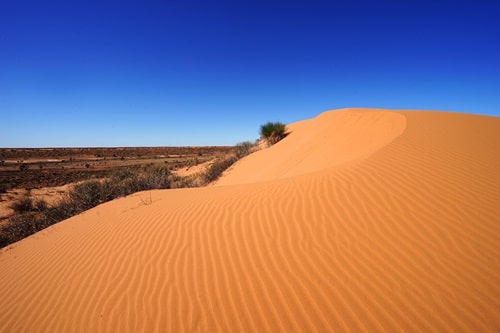Australia’s Outback is a vast and rugged region that captures the essence of the country’s natural beauty and cultural heritage. Spanning thousands of kilometers, it is a place where red desert sands meet azure skies, where unique flora and fauna thrive, and where ancient Indigenous cultures continue to be celebrated. The Outback is not just a destination; it is an experience that offers a profound connection to nature and a glimpse into the soul of Australia.
Australia’s Outback Nature is a realm of extremes, defined by vast stretches of arid and semi-arid landscapes, punctuated by rugged mountains, expansive deserts, and meandering river systems. This unique ecosystem encompasses a significant portion of Australia’s landmass, stretching across central and western regions, and is characterized by its harsh climate, sparse vegetation, and distinctive wildlife. The Outback is not just a physical place; it’s a cultural icon, deeply ingrained in the Australian identity, embodying the spirit of resilience and adaptability.
One of the defining features of the Outback is its aridity, with some areas receiving minimal rainfall, making water a precious and often scarce resource. Despite these challenging conditions, the Outback is home to a surprising array of flora and fauna specially adapted to survive in this harsh environment. Iconic plant species such as spinifex grass, mulga trees, and desert wildflowers dot the landscape, while resilient animals like kangaroos, emus, and dingoes roam the vast expanses, showcasing nature’s ability to thrive against the odds.
 The Outback’s geological heritage is equally fascinating, with ancient rock formations, such as the iconic Uluru and Kata Tjuta, serving as enduring symbols of Australia’s natural history. These colossal monoliths, sculpted over millions of years, hold profound cultural significance for Indigenous Australians, who have inhabited these lands for tens of thousands of years. The Outback is also home to a wealth of geological wonders, including the rugged Flinders Ranges, the majestic MacDonnell Ranges, and the sprawling Simpson Desert, each offering a glimpse into the Earth’s tumultuous past.
The Outback’s geological heritage is equally fascinating, with ancient rock formations, such as the iconic Uluru and Kata Tjuta, serving as enduring symbols of Australia’s natural history. These colossal monoliths, sculpted over millions of years, hold profound cultural significance for Indigenous Australians, who have inhabited these lands for tens of thousands of years. The Outback is also home to a wealth of geological wonders, including the rugged Flinders Ranges, the majestic MacDonnell Ranges, and the sprawling Simpson Desert, each offering a glimpse into the Earth’s tumultuous past.
Beyond its terrestrial landscapes, the Outback’s night skies are among the clearest and most breathtaking in the world, offering unparalleled stargazing opportunities. With minimal light pollution, visitors can witness the spectacle of the Milky Way arching across the heavens, accompanied by the dazzling display of constellations, planets, and shooting stars. For millennia, Indigenous Australians have looked to the stars for navigation, storytelling, and spiritual guidance, fostering a deep connection between the land, the sky, and the human spirit. In essence, Australia’s Outback Nature is not just a physical environment; it’s a tapestry of stories, a sanctuary of life, and a testament to the enduring power of nature in its purest form.
The landscape of the Outback is characterized by its striking contrasts. From the iconic Uluru, a massive sandstone monolith that glows red at sunrise and sunset, to the expansive Simpson Desert with its mesmerizing sand dunes, the Outback is a testament to nature’s raw beauty. This region is also home to the MacDonnell Ranges, which feature rugged mountain ranges and deep gorges that provide a dramatic backdrop for outdoor adventures. The biodiversity here is equally impressive, with unique species such as kangaroos, emus, and the elusive bilby making their home in this harsh environment.
One of the most fascinating aspects of the Outback is its Indigenous heritage. Aboriginal Australians have lived in this region for tens of thousands of years, and their deep connection to the land is evident in the rich tapestry of stories, art, and traditions that have been passed down through generations. Sacred sites like Uluru and Kata Tjuta hold immense cultural significance, and visitors are often guided by Indigenous custodians who share insights into their ancient way of life. Engaging with these communities provides a deeper understanding of the Outback's spiritual and historical importance.
The Outback also offers a unique challenge and adventure for those willing to explore its remote and often harsh terrain. Whether it’s trekking through the Larapinta Trail, a 223-kilometer path that winds through the West MacDonnell Ranges, or embarking on a 4WD journey across the Simpson Desert, the Outback demands respect and preparation. Yet, it rewards travelers with unparalleled experiences and a sense of accomplishment that comes from navigating one of the world’s last great wildernesses.
 Despite its remoteness, the Outback is not devoid of hospitality. Small towns and communities, such as Alice Springs and Coober Pedy, offer a warm welcome to visitors. Alice Springs serves as a hub for exploring the surrounding natural wonders and learning about the region’s history, while Coober Pedy, known as the opal capital of the world, invites travelers to experience life in underground homes designed to escape the intense desert heat. These towns provide a glimpse into the resilient spirit of those who call the Outback home.
Despite its remoteness, the Outback is not devoid of hospitality. Small towns and communities, such as Alice Springs and Coober Pedy, offer a warm welcome to visitors. Alice Springs serves as a hub for exploring the surrounding natural wonders and learning about the region’s history, while Coober Pedy, known as the opal capital of the world, invites travelers to experience life in underground homes designed to escape the intense desert heat. These towns provide a glimpse into the resilient spirit of those who call the Outback home.
Outback nature of Australia is a testament to the power and beauty of the natural world. It is a place where landscapes of staggering beauty meet a deep and abiding cultural heritage. Whether you're drawn by the adventure, the wildlife, or the opportunity to connect with ancient traditions, the Outback offers an experience like no other. It is a journey into the heart of Australia, where the spirit of the land and its people resonate in every rustling leaf and every whispering breeze.

